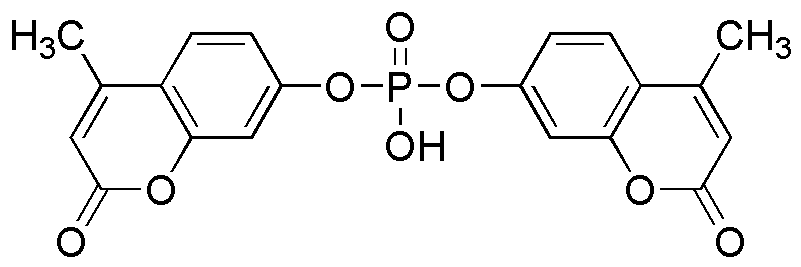Bis(4-methylumbelliferyl)phosphate is widely utilized in research focused on:
- Enzyme Activity Assays: This compound serves as a substrate for various phosphatases, allowing researchers to measure enzyme activity in biological samples effectively.
- Fluorescent Probes: It is employed in fluorescence microscopy to visualize cellular processes, providing a clear advantage in studying live cells due to its strong fluorescent properties.
- Biochemical Research: Used in studies involving signal transduction pathways, it helps in understanding cellular responses to different stimuli, aiding drug development and therapeutic research.
- Clinical Diagnostics: This compound can be utilized in diagnostic tests for certain diseases, enhancing the sensitivity and specificity of assays compared to traditional methods.
- Pharmaceutical Development: Its role in screening potential drug candidates makes it valuable in the pharmaceutical industry, particularly in the optimization of drug formulations.
General Information
Properties
Safety and Regulations
Applications
Bis(4-methylumbelliferyl)phosphate is widely utilized in research focused on:
- Enzyme Activity Assays: This compound serves as a substrate for various phosphatases, allowing researchers to measure enzyme activity in biological samples effectively.
- Fluorescent Probes: It is employed in fluorescence microscopy to visualize cellular processes, providing a clear advantage in studying live cells due to its strong fluorescent properties.
- Biochemical Research: Used in studies involving signal transduction pathways, it helps in understanding cellular responses to different stimuli, aiding drug development and therapeutic research.
- Clinical Diagnostics: This compound can be utilized in diagnostic tests for certain diseases, enhancing the sensitivity and specificity of assays compared to traditional methods.
- Pharmaceutical Development: Its role in screening potential drug candidates makes it valuable in the pharmaceutical industry, particularly in the optimization of drug formulations.
Documents
Safety Data Sheets (SDS)
The SDS provides comprehensive safety information on handling, storage, and disposal of the product.
Product Specification (PS)
The PS provides a comprehensive breakdown of the product’s properties, including chemical composition, physical state, purity, and storage requirements. It also details acceptable quality ranges and the product's intended applications.
Certificates of Analysis (COA)
Search for Certificates of Analysis (COA) by entering the products Lot Number. Lot and Batch Numbers can be found on a product’s label following the words ‘Lot’ or ‘Batch’.
*Catalog Number
*Lot Number
Certificates Of Origin (COO)
This COO confirms the country where the product was manufactured, and also details the materials and components used in it and whether it is derived from natural, synthetic, or other specific sources. This certificate may be required for customs, trade, and regulatory compliance.
*Catalog Number
*Lot Number
Safety Data Sheets (SDS)
The SDS provides comprehensive safety information on handling, storage, and disposal of the product.
DownloadProduct Specification (PS)
The PS provides a comprehensive breakdown of the product’s properties, including chemical composition, physical state, purity, and storage requirements. It also details acceptable quality ranges and the product's intended applications.
DownloadCertificates of Analysis (COA)
Search for Certificates of Analysis (COA) by entering the products Lot Number. Lot and Batch Numbers can be found on a product’s label following the words ‘Lot’ or ‘Batch’.
*Catalog Number
*Lot Number
Certificates Of Origin (COO)
This COO confirms the country where the product was manufactured, and also details the materials and components used in it and whether it is derived from natural, synthetic, or other specific sources. This certificate may be required for customs, trade, and regulatory compliance.

